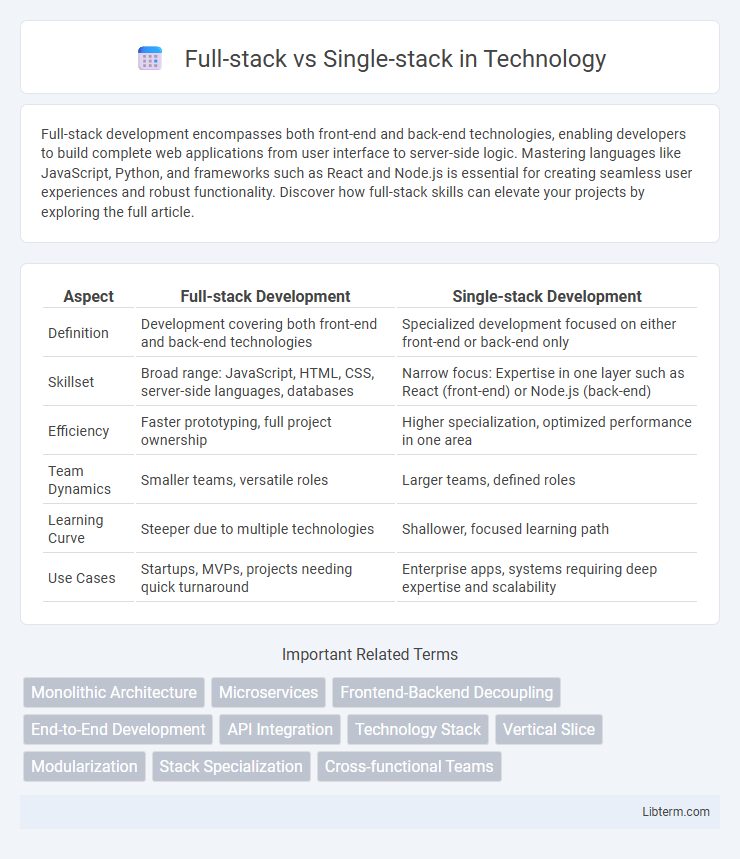Full-stack development encompasses both front-end and back-end technologies, enabling developers to build complete web applications from user interface to server-side logic. Mastering languages like JavaScript, Python, and frameworks such as React and Node.js is essential for creating seamless user experiences and robust functionality. Discover how full-stack skills can elevate your projects by exploring the full article.
Table of Comparison
| Aspect | Full-stack Development | Single-stack Development |
|---|---|---|
| Definition | Development covering both front-end and back-end technologies | Specialized development focused on either front-end or back-end only |
| Skillset | Broad range: JavaScript, HTML, CSS, server-side languages, databases | Narrow focus: Expertise in one layer such as React (front-end) or Node.js (back-end) |
| Efficiency | Faster prototyping, full project ownership | Higher specialization, optimized performance in one area |
| Team Dynamics | Smaller teams, versatile roles | Larger teams, defined roles |
| Learning Curve | Steeper due to multiple technologies | Shallower, focused learning path |
| Use Cases | Startups, MVPs, projects needing quick turnaround | Enterprise apps, systems requiring deep expertise and scalability |
Introduction to Full-stack and Single-stack Development
Full-stack development involves working with both front-end and back-end technologies to build complete web applications, allowing developers to manage databases, server-side logic, and user interfaces. Single-stack development focuses on specialization in either front-end or back-end, enabling deeper expertise in specific technologies like React.js for front-end or Node.js for back-end. Companies often seek full-stack developers for their versatility, while single-stack specialists are valued for their advanced skills in particular domains.
Defining Full-stack: Roles and Responsibilities
Full-stack development involves managing both front-end and back-end technologies, enabling developers to design user interfaces, develop server-side logic, and integrate databases efficiently. Key responsibilities include handling API development, server management, and ensuring seamless communication between client-side and server-side components. Full-stack developers possess expertise in multiple programming languages, frameworks, and tools, offering holistic solutions that drive end-to-end project execution.
What is Single-stack Development?
Single-stack development refers to specializing in one specific technology stack or programming language throughout the entire development process, allowing deep expertise in that particular stack's tools and frameworks. It streamlines development by focusing on a consistent environment, such as using JavaScript with Node.js for both frontend and backend, or Python with Django for web applications. This approach contrasts with full-stack development, which involves handling multiple technologies across frontend, backend, and database management, requiring broader but often less specialized knowledge.
Key Differences Between Full-stack and Single-stack
Full-stack development involves expertise in both front-end and back-end technologies, enabling developers to build complete applications from user interface to server-side logic, whereas single-stack developers specialize in either front-end or back-end exclusively. Full-stack developers manage databases, APIs, servers, and client-side frameworks simultaneously, while single-stack developers focus deeply on specific layers like React or Node.js. The key difference lies in the breadth of skills: full-stack offers versatility and holistic control, whereas single-stack provides specialized, in-depth expertise.
Advantages of Full-stack Development
Full-stack development offers the advantage of versatility by enabling developers to work on both front-end and back-end components, which streamlines communication and project management. This holistic approach accelerates the development process, reduces dependencies, and enhances problem-solving efficiency by allowing quick identification and resolution of issues across the entire technology stack. Full-stack developers bring comprehensive expertise in databases, servers, APIs, and user interfaces, leading to more cohesive and integrated software solutions.
Benefits of Specializing in Single-stack
Specializing in a single-stack allows developers to gain deep expertise in a specific technology set, resulting in more efficient problem-solving and higher quality code. Mastery of one stack enhances productivity and reduces the learning curve when working on complex projects within that ecosystem. Companies often seek specialists for roles requiring advanced skills in frameworks like React, Angular, or Django, making single-stack developers highly valuable in niche markets.
Skills Required for Full-stack vs Single-stack
Full-stack developers require proficiency in both front-end technologies like HTML, CSS, JavaScript, and back-end frameworks such as Node.js, Python, or Ruby, along with database management and server handling skills. Single-stack developers specialize deeply in either front-end or back-end technologies, mastering frameworks and tools specific to their chosen layer. Full-stack roles demand versatile problem-solving abilities and familiarity with multiple programming languages, while single-stack roles emphasize in-depth expertise and advanced skills within a narrower technological scope.
Common Use Cases and Project Types
Full-stack development suits projects requiring end-to-end solutions, such as web applications, e-commerce platforms, and SaaS products, by integrating front-end and back-end technologies. Single-stack development is ideal for specialized tasks like front-end interfaces using React or back-end APIs built with Node.js, focusing on specific layers without cross-domain complexity. Enterprises often choose full-stack for versatility and faster prototyping, while startups or smaller projects may prefer single-stack approaches for streamlined development and focused expertise.
Career Opportunities and Salary Comparisons
Full-stack developers possess expertise in both front-end and back-end technologies, significantly increasing their market demand and commanding average salaries ranging from $85,000 to $130,000 annually. Single-stack developers, specializing either in front-end or back-end, have narrower career opportunities with average salaries typically between $65,000 and $100,000, depending on the technology stack. Companies often prefer full-stack developers for their versatility and cost-effectiveness in project delivery, enhancing long-term career growth and earning potential.
Choosing the Right Path: Full-stack or Single-stack?
Choosing between full-stack and single-stack development depends on project scope and specialization needs. Full-stack developers manage both front-end and back-end technologies, offering versatility for end-to-end solutions, while single-stack developers focus deeply on either front-end or back-end expertise, optimizing performance in specific domains. Prioritizing team size, project complexity, and skill depth guides the decision to ensure efficient development outcomes.
Full-stack Infographic

 libterm.com
libterm.com